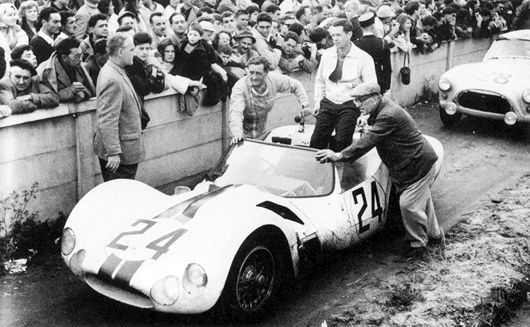Into The Sixties
Part Three – Text by Kane Rogers
In addition to his Jaguar business, Briggs had also become the eastern U.S. Maserati distributor. Having employed a number of the Italian firm’s cars over the years, he was finding their new space-frame “Birdcage” racer an immediate winner.
Briggs ended a long spell out of the winner’s circle in an early-spring race at Road America in his favored OSCA. He then took two Corvettes and a 2.9 litre Maserati to Sebring for the big spring opener, but the team did not fare well. Although they scored wins at Bridgehampton, Cumberland and the Road America Six Hours, Dick Thompson, now driving Chevrolet’s new Sting Ray, would beat Walt Hansgen for the SCCA Championship.
Briggs returned once again to Le Mans, this time to drive with Bill Kimberly in a 2.9 litre Tipo 61.
Augie Pabst paired with Dick Thompson and Walt Hansgen teamed with a young Bruce McLaren in a pair of 3.0 litre Tipo 63s. Walt took his car out early, postponing McLaren’s debut at Le Mans, but the Pabst/Thompson car finished in fourth and the little Birdcage, which spent a grand total of twelve minutes in the pits during the entire race, finished a creditable eighth.

Le Mans 1961: Co-driver Bill Kimberly enjoys the ride while Briggs and Alfred push their eighth-place Maserati Birdcage past John Baus to parc ferme. BSC Collection.
The dawn of the sixties saw the SCCA’s popularity challenged by the more professionally-oriented United States Auto Club, whose venues ranged from Canada’s St. Jovite and Mosport to Riverside and Laguna Seca in California. Purses and crowds were growing exponentially as the series attracted such talents as Stirling Moss, Jimmy Clark, Bruce McLaren and Jack Brabham. The increasing money and competition fostered more experimentation and development in the cars, a condition reflected in the growing variety of vehicles in the Cunningham stable. The Cunningham Maseratis underwent constant revisions, Cooper sports racers were fitted with Maserati, then Buick engines, and a Formula One Cooper wrecked by Hansgen at Watkins Glen became Roger Penske’s famous Zerex Special.
In 1962 at Le Mans Briggs paired with Roy Salvadori to finish fourth overall in a lightweight E-Type coupe. Driving a textbook long-distance race, the pair avoided the early dash for position and by Sunday morning had worked up to fifth, which Briggs turned into fourth by passing the Grossman/Roberts GTO on the final lap.
The team’s entry for Sebring in 1963 was significant in that the new E-Types were equipped with aluminum blocks, larger disc brakes and fuel injection, but they were swept by the Ferrari prototypes, which finished in the first three places, the Surtees/Scarfiotti 250P taking the win.
1963 was to be Briggs’ last year as an entrant and contestant at Le Mans. The team fielded three of the new lightweight E-Types; Augie Pabst paired with Walt Hansgen, exiting early Saturday night with gearbox trouble, then Roy Salvadori, driving his second Le Mans with Team Cunningham, had to be pulled from the car he shared with Paul Richards after crashing it and setting it alight. Meanwhile, Briggs and Bob Grossman, who had been invited to rejoin the team after being exiled for over-revving a Lister-Jag in an earlier race, were again driving the long-distance drive, moving from fourteenth at midnight to seventh by Sunday morning.
At 10:30am Sunday, while braking for Mulsanne corner from 165mph, Grossman felt the pivot pin in the brake-pedal linkage snap. The pedal went to the floor. Grossman tried to scrub off speed by driving against the haybales lining the escape road, but it wasn’t enough. The car slammed head-on into the bales at the end of the road, folding its nose like an accordion. After alerting Momo over the phone from the team’s nearby timing stand, Grossman nursed the car back to the pits, where the crew worked furiously to repair it with components from the two retired E-Types. Thrilling the fans cheering from the grandstands opposite the Cunningham pit, in seventy-four minutes they replaced the battered Jag’s steering, front suspension, wheels and tires, bonnet and lights. Having lost four places, Briggs and Grossman eventually brought the car back to finish ninth overall.
It was a storied end to a storied career at the Sarthe, one feted by the local fans and the people of Le Mans when they later conferred Honorary Citizenship upon Briggs for his years of sportsmanship and class, as a racer, a gentleman, and a friend.
Although Ford would soon take up the challenge at Le Mans with its GT40 prototypes, it was not until 1967, when Dan Gurney and A.J. Foyt, during a remarkable season for both these racers, would finally achieve Briggs’ long-held dream of an all-American victory, driving the now-famous Number One Mark IV.
Website Disclaimer
Please read the disclaimer prior to entering this website. You may access it by clicking here.